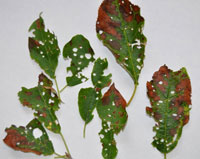Pseudomonas syringae pathovar (pv.) syringae, Coccomyces lutescens
Hosts
Chokecherry
Distribution and Disease Cycle

leaf spot infection.
Photo credit: AAFC-AAC Agroforestry Development Centre
Leaf spot on chokecherry can be caused by either a fungus or a bacterium, both causing the typical "shot-hole" lesions characteristic of the disease. Heavy infections often lead to premature defoliation with repeated infections eventually leading to tree decline.
The fungal pathogen, Coccomyces lutescens overwinters on fallen leaves, with spores dispersed from fruiting bodies in spring, spreading by wind to infect newly formed leaves. Secondary infections can also occur later in summer following production of white spore masses on infected leaves. Warm temperatures favour disease development.
The bacterial pathogen, Pseudomonas syringae pv. syringae overwinters within cankers on branches, spreading during cool, wet weather in spring. Leaves need to have standing water on them in order for the bacteria to successfully infect them. While this bacteria is commonly found on the fruit, stems and leaves of various plant species, infection levels generally correlate to weather conditions favourable to disease development. Further infections will often occur during wet periods throughout the season.
Symptoms and Signs

Infection by either pathogen results in small purple or red circular or angular spots, eventually turning brown as the tissue dies. Usually the dead tissue separates from the surrounding living tissue, leaving holes in the leaves. If humidity is high, a white spore mass may be visible on the still intact lesions of infected leaves. When infections are severe, lesions may coalesce, forming larger areas of necrotic tissue, leaves may appear chlorotic, and trees may have premature defoliation.
Control
Because there are no fungicides registered for disease control on chokecherry, pruning and sanitation are the only control measures available, but are usually not required in shelterbelt plantings.